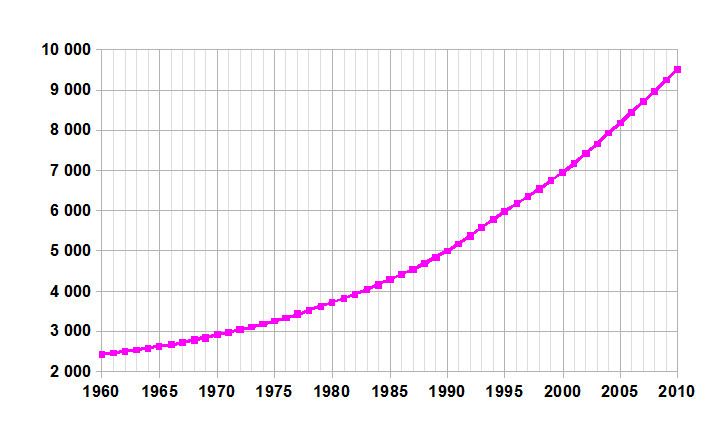 | ||
The demographics of Benin include population density, ethnicity, education level, health of the populace, economic status, religious affiliations and other aspects of the population.
Contents
- Population
- Vital statistics
- Fertility and Births
- Ethnic groups
- CIA World Factbook demographic statistics
- Age structure
- Median age
- Population growth rate
- Urbanization
- Sex ratio
- Life expectancy at birth
- HIVAIDS
- Major infectious diseases
- Nationality
- Religions
- Languages
- Literacy
- Education expenditure
- References
The majority of Benin’s 9.32 million people live in the south. The population is young, with a life expectancy of 62 years.
About 42 African ethnic groups live in this country; these various groups settled in Benin at different times and also migrated within the country. Ethnic groups include:
French is the official language but is spoken more in urban than in rural areas. The literacy rate is 52.2% adult males and 23.6% adult females, and slowly growing. Recent migrations have brought other African Nationals to Benin: Nigerians, Togolese, Malians, etc. The foreign community also includes many Lebanese and Indians involved in trade and commerce. The personnel of the many European Embassies and Foreign Aid Missions and of nongovernmental organizations and various missionary groups account for a large number of the 5,500 European population.
Several religions are practiced in Benin. African Traditional Religion is widespread (50%), and its practices vary from one ethnic group to the other. Arab merchants introduced Islam in the north and among the Yoruba. European missionaries brought Christianity to the south and central areas of Benin. Muslims account for 20% of the population and Christians for 30%. Many nominal Muslims and Christians continue to practice African Traditional Religion traditions. It is believed that West African Vodun originated in Benin and was introduced to Brazil and the Caribbean Islands by slaves taken from this particular area of the Slave Coast.
Population
According to the 2010 revision of the World Population Prospects the total population was 8 850 000 in 2010, compared to only 2 255 000 in 1950. The proportion of children below the age of 15 in 2010 was 43.7%, 53.3% were between 15 and 65 years of age, while 3% were of 65 years or older .
Vital statistics
Registration of vital events is in Benin not complete. The Population Departement of the United Nations prepared the following estimates.
Births and deaths
Fertility and Births
Total Fertility Rate (TFR) (Wanted Fertility Rate) and Crude Birth Rate (CBR):
Fertility data as of 2011-2012 (DHS Program):
Ethnic groups
There are several dozen ethnolinguistic groups in Benin, representing three of Africa's language families: Niger–Congo, Nilo-Saharan, and Afroasiatic. The latter is represented by Hausa living mostly as merchants in the north, while Nilo-Saharan is represented by the Dɛndi, descending from the Songhai Empire. The Dɛndi language predominates along the Niger River in the far north, and is used as a lingua franca in Muslim areas throughout the north, in Alibori, Borgou, and Donga provinces. Of the Niger–Congo family, five branches are represented:
The largest ethnic group are the Fon, with 1.7 million speakers of the Fon language (2001), followed by the various Yoruba groups (1.2 million), the Aja (600,000), the Bariba (460,000), the Ayizo (330,000), the Fulani (310,000), and the Gun (240,000). Near the ports in the south can be found many people who are descended from returned Brazilian slaves. There are also small numbers of Europeans, principally French, and people from the western Asia, mainly Lebanese, and East Asia, chiefly Indians.
CIA World Factbook demographic statistics
The following demographic statistics are from the CIA World Factbook, unless otherwise indicated.
Population
9,325,032Note: estimates for this country explicitly take into account the effects of excess mortality due to AIDS; this can result in lower life expectancy, higher infant mortality and death rates, lower population and growth rates, and changes in the distribution of population by age and sex than would otherwise be expected (July 2011 est.)Age structure
0-14 years: 44.7% (male 2,126,973/female 2,042,340)15-64 years: 52.6% (male 2,443,370/female 2,461,421)65 years and over: 2.7% (male 101,640/female 149,288) (2011 est.)Median age
Total:17.2 yearsMale: 16.8 yearsFemale: 17.7 years (2009 est.)Population growth rate
2.911% (2011 est.)Urbanization
Urban population: 42% of total population (2010)Rate of urbanization: 4% annual rate of change (2005-10 est.)Sex ratio
At birth: 1.05 male(s)/femaleUnder 15 years: 1.04 male(s)/female15-64 years: 0.99 male(s)/female65 years and over: 0.70 male(s)/femaleTotal population: 1.0 male(s)/female (2009 est.)Life expectancy at birth
Total population: 59 yearsMale: 57.83 yearsFemale: 60.23 years (2009 est.)HIV/AIDS
Adult prevalence rate: 1.2% (2007 est.)People living with HIV/AIDS: 64,000 (2007 est.)Deaths: 3,300 (2007 est.)Major infectious diseases
Degree of risk: very highFood or waterborne diseases: bacterial and protozoal diarrhea, hepatitis A, and typhoid feverVectorborne diseases: malaria, yellow fever, and others are high risks in some locationsRespiratory disease: meningococcal meningitisAnimal contact disease: rabies (2009)Nationality
English :Noun: Beninese (singular and plural) English :Adjective: Beninese
However, French is widely spoken throughout Benin while English speakers are few and far between. From a practical standpoint the only terms one is likely to hear while in country are Béninois (for men) and Béninoise (for women). Pronunciation (Ben-een-w-ah) is the same for both terms.
French: Noun (Male): Béninois French: Noun (Female): Béninoise
Ethnic groups
Fon and related 39.2%, Adja and related 15.2%, Yoruba and related 12.3%, Bariba and related 9.2%, Fulani and related 7%, Ottamari and related 6.1%, Yoa-Lokpa and related 4%, Dendi and related 2.5%, Other 1.6%, Unspecified 2.9% (2002 est.)Religions
Roman Catholic 27.1%, Islam 24.4%, Vodoun 17.3%, Protestant 10.4% (Celestial 5%, Methodist 3.2%, other Protestant 2.2%), other Traditional Religions 6%, other Christian 5.3%, Other 1.9%, None 6.5%, Unspecified 1.1% (2002 est.)Languages
Over 50 languages are spoken in Benin. The official language is French. Of the many indigenous African languages, Fon and Yoruba are the most important in southern Benin, and in the north there are at least six major languages, including Baatonum and Fulani.
